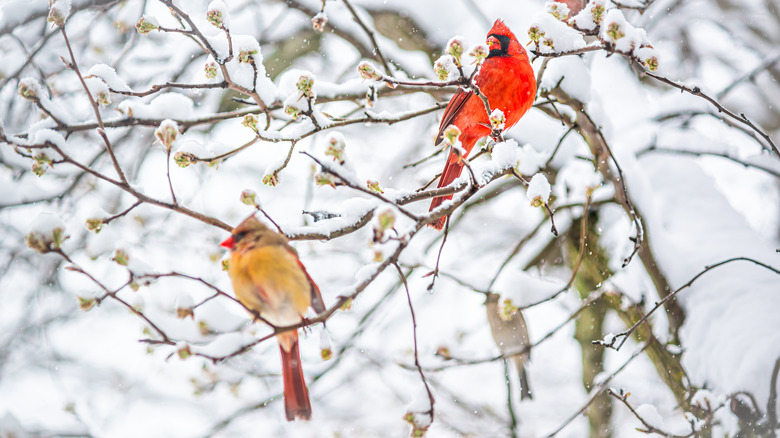How To Provide Access To Fresh Water For Backyard Birds In Winter
We may receive a commission on purchases made from links.
Backyard birds need access to fresh water to drink in winter. This is especially important when temperatures fall below freezing and their usual natural water sources (like streams, ponds or birdbaths) freeze over. In addition to keeping your bird feeders filled, providing fresh water is an important part of caring for the feathered friends who visit your garden in winter. We've rounded up some simple ways to help your backyard birds get the water they need in cold weather to stay happy and hydrated.
One simple way to keep water accessible is to get a heated birdbath, bubbler, or a de-icer to place in your birdbath. Heated birdbaths come in a variety of designs, including solar-powered, and at a wide range of price points. Because most of them are electric, you want to exercise appropriate precautions using them. Make sure their plugs are sheltered from rain and moisture, and check them for icing when temperatures freeze. Some heated birdbaths can be used all year round and the heating elements can be turned on as needed in cold weather.
A bubbler is another option: The benefit of having a fountain or bubbler in your birdbath is that it keeps the water moving. They also come in simple solar designs, but unless there is bright sunlight available, and plenty of sunny weather, these may not work consistently in winter. Be sure to check the product specs to make sure it will work to keep ice from forming in freezing temperatures. A de-icer works to melt ice once it is already formed on the birdbath. A de-icer also tends to be a more affordable option than an entire heated birdbath. For example, the Saillong Bird Bath De-icer goes for $29.99 at the time of writing, while an entire heated bird bath can cost upwards of $100.
Safety concerns for birdbaths in winter
On very cold days, a bird bathing in a heated birdbath might experience the water on its feathers freezing after it leaves the birdbath. For this reason, having a birdbath big enough for submersion might be dangerous for birds. Putting a non-metallic grille over the top of the birdbath allows birds to insert their beaks to drink but won't let them put their bodies in the water; you can try weaving sticks over the top to prevent birds from bathing. You can also use a heated dog bowl, and fill it with clean pebbles (or add rocks to your birdbath) so the water level is too shallow for bathing, but still allows birds to drink.
In some cases, an electric birdbath or de-icer isn't practical, whether due to the location of your birdbath, or lack of access to electricity. There are other ways to provide fresh water to birds in cold weather that are a bit less high-tech. One method to try is placing a shallow bowl or plant saucer of water out for birds to access while it remains unfrozen. Then bring it back inside when it freezes. If you do this at the same time each day, your backyard birds should begin to recognize the timing and be there for the water before it freezes.
If you have a concrete birdbath, it's best to empty it of water and cover it in winter, because if it freezes with water inside it, it may crack or leak. There are birdbaths available now made from a variety of materials. You should also clean your birdbath regularly during the winter months.

